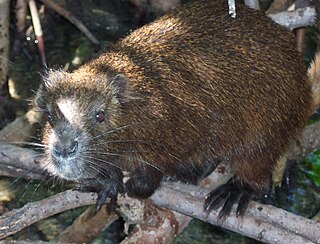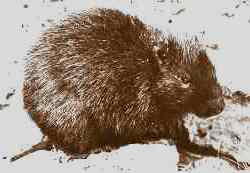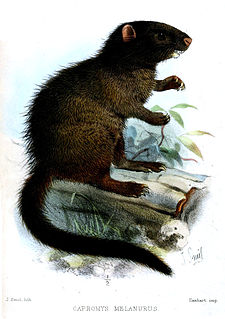Swan Island may refer to:
The giant hutias are an extinct group of large rodents known from fossil and subfossil material in the West Indies. One species, Amblyrhiza inundata, is estimated to have weighed between 50 and 200 kg, big specimens being as large as an American black bear. This is twice as large as the capybara, the largest rodent living today, but still much smaller than Josephoartigasia monesi, the largest rodent known. These animals were probably used as a food source by aboriginal humans. All giant hutias are in a single family, Heptaxodontidae, which contains no living species; this grouping seems to be paraphyletic and arbitrary, however.

Hutias are moderately large cavy-like rodents of the family Capromyidae that inhabit the Caribbean Islands. Twenty species of hutia have been identified but at least a third are extinct. Only Desmarest's hutia and the prehensile-tailed hutia remain common and widespread; all other extant species are considered threatened by the IUCN. Their larger relatives, the giant hutias of the family Heptaxodontidae, are entirely extinct.
The dwarf hutia is known only from Cuba. It was last seen in 1937.

Geocapromys is a genus of rodent belonging to the hutia family and are currently only found on the Bahamas and Jamaica. However, they formerly ranged throughout the Caribbean, from Cuba to the Cayman Islands to even islands off mainland Central America.

The Jamaican coney, also known as the Jamaican hutia and the Browns hutia, is a hutia endemic to Jamaica. It is in the order Rodentia and the family Capromyidae. It is the only extant native land mammal on Jamaica besides bats.

The Hispaniolan hutia is a hutia species endemic to the island of Hispaniola. It is the only confirmed extant species of the genus Plagiodontia, and the only extant species of hutia on Hispaniola; other species are either extinct or being debatedly catalogued as P. aedium subspecies. The name Plagiodontia means "oblique tooth" in Greek, referring to its dentition. Along with the often sympatric Hispaniolan solenodon, it is one of two extant native mammals on Hispaniola.

The Desmarest's hutia, also known as the Cuban hutia, is a species of rodent endemic to Cuba, although an extinct subspecies is known from the Cayman Islands. Weighing up to 8.5 kg (19 lb), it is the largest of the extant species of hutia.
The Cuban coney is an extinct species of rodent in the family Capromyidae. It was endemic to Cuba. Its natural habitats were lowlands moist forests, xeric shrublands and rocky areas. Some scientists indicate that this species may have survived and coexisted with introduced species from the Old World until approximately 1500, while others indicate that it became extinct earlier in the Holocene.

The Bahamian hutia or Ingraham's hutia is a species of hutia in the family Capromyidae native to the Bahamas. Its natural habitats are subtropical or tropical moist lowland forest, subtropical or tropical dry shrubland, and rocky areas.

Mesocapromys is a genus of rodent in the family Capromyidae. The genus is restricted to Cuba and associated islands.
The eared hutia or large-eared hutia is a species of rodent in the family Capromyidae. It is endemic to the island of Cayo Fragoso off the northern coast of Cuba.

Mysateles is a genus of rodent in the family Capromyidae. The genus is restricted to Cuba.

The black-tailed hutia(Mysateles melanurus), also known as the bushy-tailed hutia, is a species of rodent in the family Capromyidae that is endemic to lowland moist forests in Cuba. It is threatened by habitat loss.
The Isla De La Juventud tree hutia or southern hutia is a species of rodent in the family Capromyidae. It is endemic to lowland moist forests on Isla de la Juventud in Cuba. It is threatened by habitat loss.
Plagiodontia is a genus of rodent in the family Capromyidae.
Osborn's key mouse, also known as the larger Jamaican giant hutia, is a now extinct species of large rodent in the family Heptaxodontidae. It was found on the island of Jamaica and likely became extinct before the end of the Pleistocene. Osborn's key mouse has only been found in six caves: Wallingford Roadside Cave, Sheep Pen Cave, Molton Fissure, Worthy Park Cave 1, Luidas Vale Cave, and Slue's Cave.








